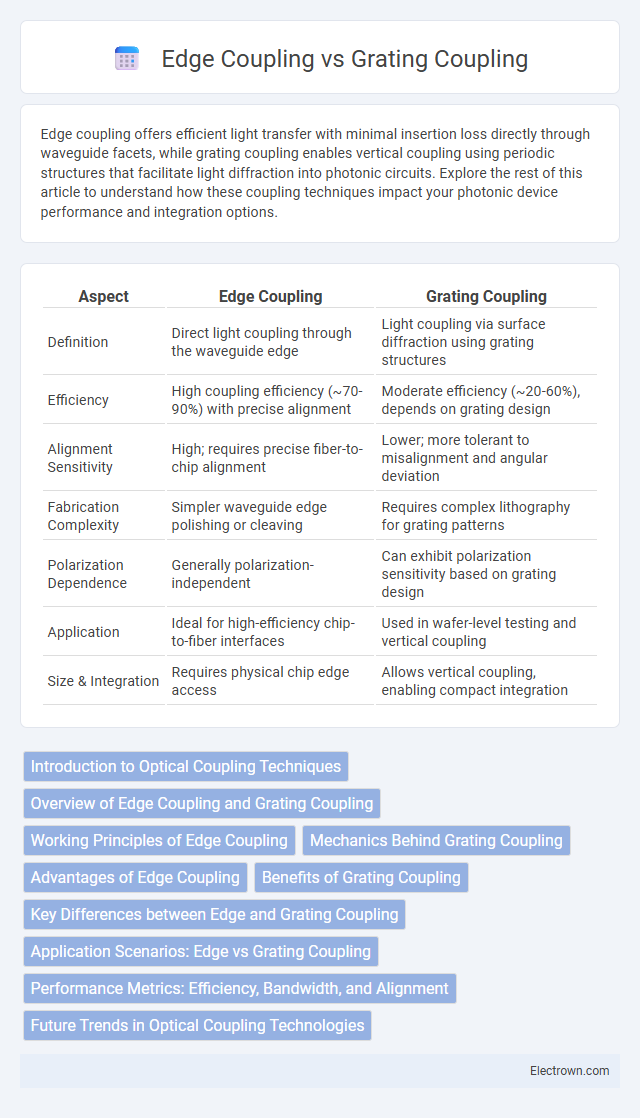Edge coupling offers efficient light transfer with minimal insertion loss directly through waveguide facets, while grating coupling enables vertical coupling using periodic structures that facilitate light diffraction into photonic circuits. Explore the rest of this article to understand how these coupling techniques impact your photonic device performance and integration options.
Table of Comparison
| Aspect | Edge Coupling | Grating Coupling |
|---|---|---|
| Definition | Direct light coupling through the waveguide edge | Light coupling via surface diffraction using grating structures |
| Efficiency | High coupling efficiency (~70-90%) with precise alignment | Moderate efficiency (~20-60%), depends on grating design |
| Alignment Sensitivity | High; requires precise fiber-to-chip alignment | Lower; more tolerant to misalignment and angular deviation |
| Fabrication Complexity | Simpler waveguide edge polishing or cleaving | Requires complex lithography for grating patterns |
| Polarization Dependence | Generally polarization-independent | Can exhibit polarization sensitivity based on grating design |
| Application | Ideal for high-efficiency chip-to-fiber interfaces | Used in wafer-level testing and vertical coupling |
| Size & Integration | Requires physical chip edge access | Allows vertical coupling, enabling compact integration |
Introduction to Optical Coupling Techniques
Optical coupling techniques such as edge coupling and grating coupling serve essential roles in connecting optical fibers to photonic devices, enhancing signal transmission efficiency. Edge coupling involves aligning the fiber directly to the waveguide facet for minimal insertion loss and high coupling efficiency, commonly used in integrated photonics. Grating coupling employs periodic structures on the waveguide surface to diffract light into the fiber, enabling vertical coupling suitable for wafer-level testing and complex photonic circuits.
Overview of Edge Coupling and Grating Coupling
Edge coupling involves directly aligning the optical fiber with the waveguide facet to transfer light, offering low insertion loss and high efficiency in integrated photonics. Grating coupling utilizes diffraction gratings etched on the waveguide surface to couple light at specific angles, enabling easier vertical coupling but with typically higher insertion losses. Both methods are essential for interfacing optical fibers with photonic chips, with edge coupling favored for broadband applications and grating coupling preferred for wafer-scale testing and vertical integration.
Working Principles of Edge Coupling
Edge coupling operates by aligning a fiber optic cable directly to the cleaved edge of a waveguide, allowing light to transfer efficiently through the physical interface. This technique relies on precise mode matching between the fiber core and the waveguide mode to minimize insertion loss. The direct evanescent field overlap at the waveguide facet ensures high coupling efficiency, particularly effective for planar lightwave circuits.
Mechanics Behind Grating Coupling
Grating coupling operates by diffracting incoming light through a periodic structure etched onto the waveguide surface, enabling efficient coupling between free-space beams and photonic devices. The grating's pitch and depth are meticulously designed to match the phase-matching conditions required for optimal light transfer at specific wavelengths. This mechanism contrasts with edge coupling, which relies on direct physical alignment between optical fibers and waveguide facets to achieve light transmission.
Advantages of Edge Coupling
Edge coupling offers high efficiency and low insertion loss due to the direct alignment between the fiber core and the waveguide edge, enabling better mode overlap and reduced signal degradation. It supports broadband operation without the wavelength sensitivity commonly found in grating coupling, making it ideal for a wide range of optical communications applications. Your system benefits from easier packaging and alignment tolerance, resulting in improved reliability and lower manufacturing costs.
Benefits of Grating Coupling
Grating coupling offers precise light coupling into on-chip photonic waveguides by leveraging diffraction, enabling efficient vertical coupling from optical fibers without requiring complex alignment processes. This technique supports compact device integration and allows for broadband operation due to its wavelength-selective properties. Your photonic circuits benefit from simpler packaging and enhanced scalability compared to edge coupling.
Key Differences between Edge and Grating Coupling
Edge coupling involves directly aligning an optical fiber to the waveguide facet, providing low-loss and broadband performance ideal for high-speed data transmission. Grating coupling utilizes diffractive gratings etched on the waveguide surface to couple light vertically, offering easier alignment and compatibility with wafer-scale testing but often with higher insertion loss and wavelength sensitivity. The choice between edge and grating coupling depends on factors like integration complexity, coupling efficiency, and operational bandwidth requirements in photonic integrated circuits.
Application Scenarios: Edge vs Grating Coupling
Edge coupling excels in applications requiring high-efficiency fiber-to-chip connections, such as in dense photonic integrated circuits and telecommunications where minimal insertion loss is critical. Grating coupling is preferred for wafer-scale testing, sensing, and applications needing vertical light coupling, offering easier alignment and integration with surface-normal optics. Your choice depends on whether lateral fiber alignment (edge coupling) or vertical access and broader testing capability (grating coupling) better suits the specific photonic system requirements.
Performance Metrics: Efficiency, Bandwidth, and Alignment
Edge coupling offers high efficiency and broad bandwidth due to direct fiber-to-waveguide interface, minimizing insertion loss and allowing wide spectral range. Grating coupling provides ease of alignment with vertical coupling but typically suffers from lower efficiency and narrower bandwidth caused by diffraction limitations. Your application benefits from edge coupling's superior performance metrics when maximizing throughput and spectral coverage is critical.
Future Trends in Optical Coupling Technologies
Future trends in optical coupling technologies emphasize improving coupling efficiency and bandwidth in integrated photonic circuits. Edge coupling offers lower insertion loss and higher alignment tolerance, making it suitable for high-speed data communication and miniaturized photonic devices. Grating coupling continues to evolve with metasurface-enhanced designs, enabling compact vertical coupling and seamless integration with silicon photonics for emerging applications in quantum computing and 5G networks.
Edge coupling vs Grating coupling Infographic

 electrown.com
electrown.com